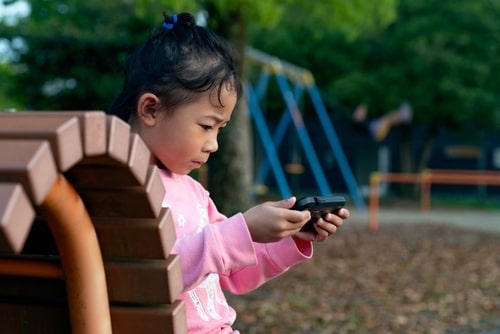Advice
Kids are losing fitness during the summer. How do we fight back?

In affluent, industrialized countries, there is a lot of discussion about children’s lack of physical activity. However, what is often overlooked is the seasonal aspect: Kids tend to be less active during the summer months, leading to a decrease in physical fitness. How significant is this decline, and what can be done to address it?


Brisk walking. Skateboarding. Biking on a level road. These are examples of what researchers call “moderate intensity physical activity.”
Moving up a level to vigorous activity, we’re talking about things like jogging and playing basketball.
Combining these activities, we get “moderate-to-vigorous physical activity,” or MVPA.
How much MVPA should kids be getting each day?
If we want to understand what has been normal throughout human evolution, it’s logical to look at the habits of contemporary hunter-gatherers—the group whose way of life most closely resembles that of our ancestors. Among the BaYaka people, for example, children engage in an average of 3 hours of MVPA each day (Kretschmer et al 2023).
However, the World Health Organization has set a more modest recommendation for children between the ages of 6 and 17: about 60 minutes of MVPA each day.
Are children in industrialized countries meeting this target?
Unfortunately, most are falling far short (Rollo et al 2020). Moreover, this assessment is based on measurements taken during the school year. If we consider how children fare during the summer break instead, the situation appears even more concerning.
So how do we know all this, and what can be done about it? Let’s delve into the evidence.
Evidence: Kids tend to become more sedentary over the summer
In a recent analysis, researchers reviewed several studies reporting on changes in children’s health behaviors during the summer (Eglitis et al 2024). What did they discover?
In 5 out of 7 studies, children actually became more sedentary during the summer.
While these increases in sedentary behavior weren’t necessarily significant across the board, it’s noteworthy considering that most children are already insufficiently active. But what about MVPA? Does that also decrease?
Summertime fitness deficit: Kids get less MVPA
While it’s easy to ask children to estimate their activity levels, the results can be unreliable. Therefore, Amanda Watson and her team used wrist accelerometers (similar to Fitbit) to observe a drop in MVPA among 9-year-old children in Australia during the summer.
Over a two-year period, the researchers monitored children at five different time points, measuring their activity levels during both the school year and the summer. The results showed that, on average, children spent about 27 more minutes per day being sedentary and about 12 minutes less engaging in moderate-to-vigorous physical activity (Watson et al 2023).
If we consider this 12-minute decrease in MVPA to be accurate, how significant is it in terms of children’s health and fitness? Further research indicates that it does make a difference.
Children’s summertime losses in cardiovascular endurance
In a related study, the same research team assessed changes in aerobic fitness using the shuttle run test, also known as the Progressive Aerobic Cardiovascular Endurance Run (PACER). This test requires running back and forth over a 20-meter distance at an increasing pace. The more laps a child completes, the higher their cardiovascular fitness.
Once again, researchers focused on children around 9 years old, testing them at multiple points over a two-year period.
Unfortunately, the researchers noted a rapid decline in physical fitness over the summer break. Upon returning to school after the break, children showed a decrease in performance, running out of steam faster compared to their school-term performance (Olds et al 2023).
Similar findings were reported for children in the upper grades of primary school in the United States, with older children experiencing the most significant decline in aerobic fitness. For instance, 6th graders who averaged about 43 PACER laps at the end of the school year completed only about 27 laps after returning from summer break (Fu et al 2017).
There is a consistent pattern of reduced physical activity during the summer, leading to a decline in aerobic fitness. This contradicts the traditional image of children enjoying plenty of exercise and outdoor activities during the summer break, free from the confines of the classroom.
Why are kids experiencing summer fitness loss?
There have been significant changes in popular culture, such as the increased use of video games, social media, and the perception that children are only safe outdoors under constant adult supervision. Additionally, weather-related conditions like summer heat waves and wildfire smoke can hinder outdoor exercise (Watson et al 2023).
It’s evident that we cannot assume children will engage in healthy levels of physical activity simply because it’s summer break.
Just as many children experience summer learning loss, they may also suffer declines in physical fitness. It’s essential to remember that these two aspects of life are interconnected. Research suggests that aerobic exercise can help children enhance their cognitive functions.
What can be done to enhance children’s fitness levels?
1. When weather permits, encourage outdoor activities for children, but recognize that it may not be sufficient on its own.
Outdoor play offers numerous health benefits and can increase moderate-to-vigorous physical activity levels. However, outdoor activities may not have a significant impact, especially among older children (Larouche et al 2018). Therefore, additional measures should be taken.
2. Facilitate connections between children and active peers in safe and engaging exercise spaces.
Research suggests that children, especially younger ones, tend to be more active when with friends or siblings (Pearce et al 2014). The environment also plays a role; children are more active when they have access to stimulating playground equipment (Gustat et al 2023) or when their urban neighborhoods restrict street traffic to create safe play spaces (d’Haease et al 2015).
Older children may require more structure and accountability to maintain activity levels, making team sports (Pearse et al 2018) and fitness classes beneficial.
3. Promote nature walks.
Walking in natural, green environments not only combats sedentary behavior and boosts cardiovascular fitness but also improves mood, reduces stress, and prevents rumination.
4. For parents with very young children who struggle to find time for their own workouts,
taking your toddler for a walk or supervising outdoor play may not provide moderate-to-vigorous physical activity for adults. To address this, you can engage in physical activity by walking laps around the play area while maintaining visual contact with the child.
5. Consider using a fitness tracker for older children who lack motivation.
While some may be hesitant to rely on technology, gamifying physical activity with a fitness tracker could be beneficial. A meta-analysis of published studies found that fitness trackers alone did not increase moderate-to-vigorous activity. However, when combined with other efforts, they led to reduced sedentary behavior, increased light physical activity, improved muscle strength, and agility in children (Wang et al 2024). In obese children, fitness tracking apps promoting exercise and dietary changes can help reduce BMI (e.g., Tugault-Lafleur et al 2023).
6. Encourage children to walk and play with the family dog.
Simply owning a dog may not increase children’s fitness levels, but when adolescents take responsibility for walking the dog, they engage in more physical activity, including moderate-to-vigorous physical activity (Pajaujiene and Petrigna 2024).
7. When indoor activities are necessary due to heat or poor air quality, consider martial arts or aerobic dancing.
Both martial arts and aerobic dancing offer high levels of moderate-to-vigorous physical activity. A review of martial arts participation in children revealed improvements in cardiovascular fitness, strength, agility, coordination, speed, and balance (Stamenković et al 2022).
While dance classes may not consistently improve cardiovascular fitness, ensuring children engage in high-intensity exercise during the class can help meet MVPA requirements (Dos Santos et al 2021).
More reading from Gwen Dewar and Parenting Science
For more insights into potential issues during the summer, check out my article on summer learning loss. To explore further information on health and exercise in children, refer to these articles:
References: Summer fitness in children
D’Haese S, Van Dyck D, De Bourdeaudhuij I, Deforche B, Cardon G. 2015. Organizing “Play Streets” during school vacations can increase physical activity and decrease sedentary time in children. Int J Behav Nutr Phys Act. 12:14.
Dos Santos GC, Queiroz JDN, Reischak-Oliveira Á, Rodrigues-Krause J. 2021. Effects of dancing on physical activity levels of children and adolescents: a systematic review. Complement Ther Med. 56:102586.
Eglitis E, Miatke A, Virgara R, Machell A, Olds T, Richardson M, Maher C. 2024. Children’s Health, Wellbeing and Academic Outcomes over the Summer Holidays: A Scoping Review. Children. 11(3):287.
Fu Y, Brusseau TA, Hannon JC, and Burns RD. 2017. Effect of a 12-Week Summer Break on School Day Physical Activity and Health-Related Fitness in Low-Income Children from CSPAP Schools. J Environ Public Health. 2017:9760817.
Gustat J, Anderson CE, and Slater SJ. 2023. Association of Playground “Playability” With Physical Activity and Energy Expenditure. Prev Chronic Dis. 20:E33.
Olds T, Dumuid D, Eglitis E, Golley R, Fraysse F, Miatke A, Tomkinson GR, Watson A, Munzberg M, Maher C. 2023. Changes in fitness and fatness in Australian schoolchildren during the summer holidays: fitness lost, fatness regained? A cohort study. BMC Public Health. 23(1):2094.
Pajaujiene S and Petrigna L. 2024. Walking and Playing with the Dog to Improve the Physical Activity Level of Adolescents: A Scoping Review. Healthcare (Basel). 12(6):631.
Pearce M, Page AS, Griffin TP, Cooper AR. 2014. Who children spend time with after school: associations with objectively recorded indoor and outdoor physical activity. Int J Behav Nutr Phys Act. 11(1):45
Pearce M, Saunders DH, Allison P, Turner AP. 2018. Indoor and Outdoor Context-Specific Contributions to Early Adolescent Moderate to Vigorous Physical Activity as Measured by Combined Diary, Accelerometer, and GPS. J Phys Act Health. 15(1):40-45.
Rollo S, Antsygina O, Tremblay MS. The whole day matters: Understanding 24-hour movement guideline adherence and relationships with health indicators across the lifespan. J Sport Health Sci. 2020 Dec;9(6):493-510.
Stamenković A, Manić M, Roklicer R, Trivić T, Malović P, Drid P. 2022. Effects of Participating in Martial Arts in Children: A Systematic Review. Children (Basel). 9(8):1203.
Tugault-Lafleur CN, De-Jongh González O, Macdonald J, Bradbury J, Warshawski T, Ball GDC, Morrison K, Ho J, Hamilton J, Buchholz A, Mâsse L. 2023. Efficacy of the Aim2Be Intervention in Changing Lifestyle Behaviors Among Adolescents With Overweight and Obesity: Randomized Controlled Trial. J Med Internet Res. 25:e38545.
Wang JW, Zhu Z, Shuling Z, Fan J, Jin Y, Gao ZL, Chen WD, Li X. 2024. Effectiveness of mHealth App-Based Interventions for Increasing Physical Activity and Improving Physical Fitness in Children and Adolescents: Systematic Review and Meta-Analysis. JMIR Mhealth Uhealth 12:e51478.
Watson A, Maher C, Golley R, Dumuid D, Manson A, Tomkinson G, Fraysse F, Olds T. 2023. Children’s activity and diet behaviors in the summer holidays versus school year. Pediatr Obes. 18(7):e13029.
Weaver RG, Hensing C, Armstrong B, Adams EL, Beets M. 2022. Seasonal Shifts in Children’s Sedentary Behaviors, Physical Activity, and Sleep: A Systematic Review and meta-Analysis. Pediatr Clin North Am. 69(4):671-693.
Image of young girl at playground, with her head buried in her phone by Shutterstock / Macky Albor
-

 Destination8 months ago
Destination8 months agoSingapore Airlines CEO set to join board of Air India, BA News, BA
-

 Breaking News10 months ago
Breaking News10 months agoCroatia to reintroduce compulsory military draft as regional tensions soar
-

 Gadgets3 months ago
Gadgets3 months agoSupernatural Season 16 Revival News, Cast, Plot and Release Date
-

 Tech News12 months ago
Tech News12 months agoBangladeshi police agents accused of selling citizens’ personal information on Telegram
-

 Productivity11 months ago
Productivity11 months agoHow Your Contact Center Can Become A Customer Engagement Center
-

 Gadgets3 weeks ago
Gadgets3 weeks agoFallout Season 2 Potential Release Date, Cast, Plot and News
-

 Breaking News10 months ago
Breaking News10 months agoBangladesh crisis: Refaat Ahmed sworn in as Bangladesh’s new chief justice
-

 Toys12 months ago
Toys12 months ago15 of the Best Trike & Tricycles Mums Recommend























